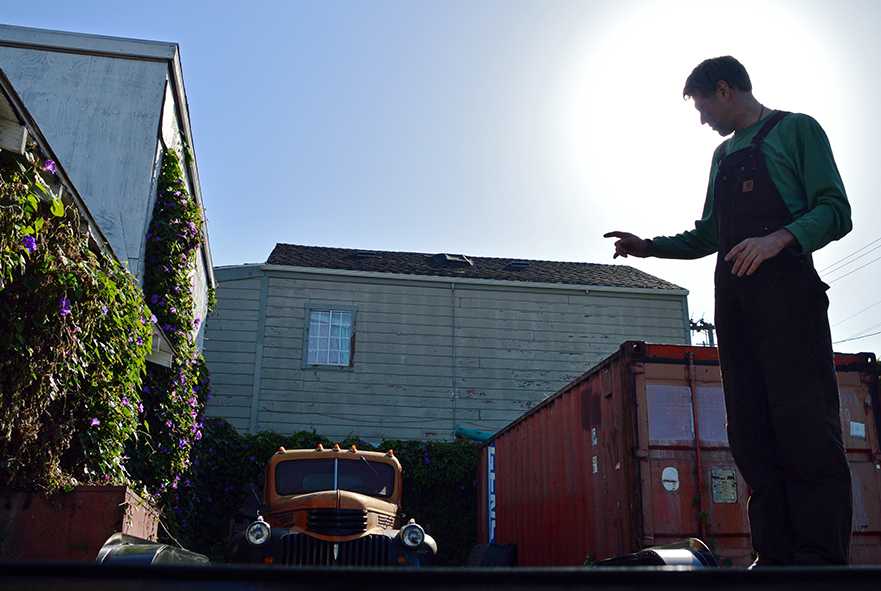Future tiny house builder, Alain Despatie stands on his trailer where his tiny home will be built in West Oakland. Photo by Katie Lewellyn
A worn-down barn with chipped white paint serves as the backdrop while Alain Despatie struggles to stay balanced on his tiny two-legged folding chair. He points to blueprints laid out on the ground by his feet, displaying the plans for his tiny, future home. Despatie is just one of the many counter culturists taking part in the global phenomenon known as the Tiny House Movement.
The exact origins of the Tiny House Movement are difficult to pinpoint, but the idea of tiny living became highly popularized after the 2008 recession, according to Jay Shafer, who is considered by some the founder of the movement. Since then, skyrocketing housing prices and environmental concerns have led some Bay Area individuals to re-think traditional housing scales and take part in the evolution.
Riding on his motorcycle through the outback in Australia, Despatie had an epiphany. In the first 40 years of his life he established a sedentary lifestyle; owned a home, had a six-figure income, and started a family. However, when his family and house diminished, he embarked on a yearlong motorcycle journey across Australia. “I dropped everything,” he recalls.
For the next year his home would consist of a 3-foot tall tent and the little belongings he kept, like the tiny fold out chair he sits on today. Looking for a compromise between a nomadic and sedentary life, he discovered the house on wheels. With less than $25,000 he could build a solar-powered home from the ground up. “If you really want to live green, with little impact on the planet, you may have to give up sedentary life because that’s part of what’s breaking [the planet],” he says.
According to data collected by the Census Bureau, the average size of homes built in 2013 hit an all-time high of 2,600 square feet, almost twice the size of homes built only thirty years ago. Despite bigger homes, the average household size in America has been on a steady decline for the past 50 years, according to the data.
A tiny house is defined as a home typically ranging anywhere from 100 to 400 square feet. Due to building code restrictions, dwellings of that size are prohibited from being permanently anchored to the ground. David Ludwig, a tiny home architect who has been living in his own 212 square foot Airstream trailer for the past nine years, explains that under both the Universal Building Code and California’s state building code, tiny house builders are restricted.

The building code was designed around the idea that every home is permanently built to the ground. Their main concern is safety, ensuring that rooms fit minimum sizing requirements to host full size appliances. “Those minimum size restrictions are actually impacting the Tiny House Movement because if tiny houses were built and anchored to the ground, their rooms would be too small to meet the building code,” says Ludwig.
By putting the homes on wheels, tiny houses are exempt from building code requirements and can therefore have smaller bathrooms, kitchens, and living rooms.
About three weeks ago, Despatie traveled to Oakland from Portland with a 20-foot long flatbed trailer attached to a rented U-Haul truck. Today, the forest green trailer bed lies in the midst of blooming flower buds. Long, green grass pokes through the metal frame as Despatie jumps on top of it, animatedly plotting out his future sustainable home.
“I really believe in the idea of a nomadic lifestyle. I’m going to move this maybe once or twice a year with the seasons,” he says.
Legally constructing tiny homes is only half of the battle; the other half is finding a place to park it.
While streaming “Tiny” on Netflix, a documentary about living small, Aimee Brown began obsessing over the idea of having her own tiny house. But after an unsuccessful Craigslist post looking for land to house her shed, she joined countless of others in the Bay Area who are actively trying to negotiate the use of land.
The Tiny House Bay Area Meet Up online group was created to form a community, as well as a support group, for people with tiny homes and those interested in the idea of owning their own. The most popular discussion on the page is the idea of building a tiny house village.
The executive order, Not in My Backyard (NIMBY), gives established members of the community a political voice to say they do not want tiny house villages in their neighborhood. Ludwig sees the local code as discrimination from homeowners who believe that villages will lower their property value.
“The people that are established in the communities are fearful because tiny home communities look an awful lot like the trailer parks of the 1950s,” he says.
In the 1950s, trailer parks were notorious for housing low-income individuals who had trouble with the law, according to Ludwig.
Amy Farah Weiss, who is running for Mayor of San Francisco, is proposing a village that would house 100 tiny homes as a prototype. Her proposal will create low-cost dwellings for individuals who will pay 30 percent of their income. Weiss’ ultimate goal is to pass legislation where Additional Dwelling Units (ADUs) are allowed in backyards and bypass NIMBY.
“What we want to do is create a new understanding about what a tiny house community is,” explains Ludwig. “The way it’s different is that people in the tiny house community want a communal lifestyle, which is supportive rather than isolationist.”
Until such legislation passes, Despatie is trying to stay as low-key as possible while he begins to build his home. He was able to get his hands on basic housing plans from a designer through an online trade.“It’s hard to hide a 13 foot house on a set of wheels, but we have to build it in a way that is respectful of the neighborhood,” he explains.

“I want to make it as cute as possible, and as least offensive as possible, in order to not generate a complaint,” he adds.
Despatie has been able to find community and support from the tiny house meet up group as he begins the process of building his home. “People are really into it, they want to know what’s going on,” he says.
Unexpectedly, dozens of individuals who want to take part in the movement, but may not have the courage to do so, have offered to help Despatie build.
“I found an in between, this house on wheels that can go wherever it’s suitable and I can take off whenever I want,” Despatie says. “To me, that was the lifestyle that I needed. It took me 40 years to find out what I wanted.”
From an economic and environmental standpoint, tiny houses seem to be the wave of the future. But it’s inevitable that in America we like things BIG.
For Despatie, his future is uncertain, ready to go at a moments notice. “If the city comes and shuts this whole place down, I put everything on my bike and that’s it,” he says.









home design college • Dec 10, 2016 at 10:13 am
I am truly grateful to the holder of this web site who has shared this fantastic piece of
writing at at this place.